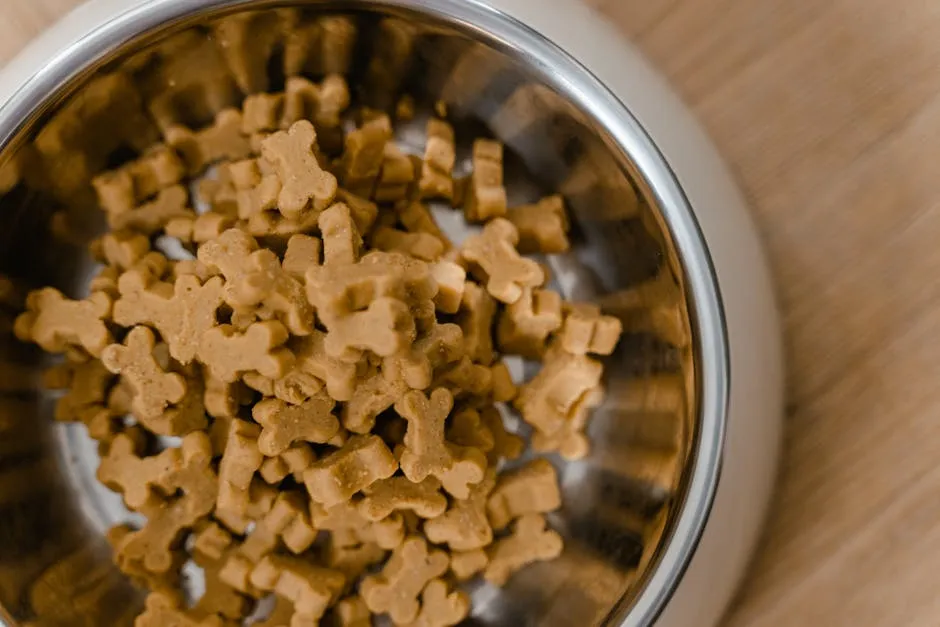Introduction
Are you considering raw food rotation for your pets? This concept is gaining traction among pet owners. Many believe a raw diet can improve their pets’ health and happiness. This article will shed light on the benefits and practices of raw food rotation. To kick things off, check out Stella & Chewy’s Raw Dog Food for a premium start!
Summary and Overview
Raw food rotation involves varying the types of proteins in your pet’s meals. It’s essential for maintaining optimal health and wellbeing. This practice ensures your pet receives a balanced nutrient profile. It also helps prevent food sensitivities and keeps mealtime interesting. In this guide, we’ll explore the benefits of nutritional diversity, strategies for implementing rotation, and best practices for keeping your pets engaged with their food. By the end, you’ll understand why switching up proteins can lead to a happier, healthier pet.
Speaking of variety, have you considered incorporating Instinct’s Raw Cat Food? It’s perfect for our feline friends who deserve a raw treat too!

Benefits of Raw Food Rotation
Nutritional Diversity
Nutritional diversity is crucial for your pet’s health. Each protein source offers unique vitamins, minerals, and amino acids. For example, chicken is rich in magnesium and vitamin E, while beef provides vitamin B12 and iron. By rotating these proteins, you can ensure your pet gets a balanced nutrient profile. If you want to boost your dog’s diet even further, consider adding Kelp Meal Powder for a nutrient boost!
Research indicates that pets on rotational diets are less likely to experience nutritional deficiencies. In fact, pets that consistently eat the same protein may face higher risks of health issues. Rotating proteins helps promote a balanced diet over time, ensuring your pet thrives.
Consider your own meals; variety keeps things interesting and satisfying. The same goes for your furry friends! Evaluate your pet’s current diet and see if it includes a range of proteins. This small change could lead to significant health benefits for your pet.

Preventing Food Sensitivities
Feeding your pet the same protein daily may lead to food allergies. Over time, prolonged exposure to a single protein can trigger sensitivity reactions. Symptoms often include itchy skin, upset stomach, and more. Research shows that food allergies affect around 10% of pets, making this a significant concern for pet owners.
Rotating proteins can help reduce these risks. By introducing a variety of proteins into your pet’s diet, you provide a range of nutrients while minimizing the chance of developing food intolerances. This practice not only supports your pet’s immune response but also promotes overall health.
If you’re looking for a tasty alternative to chicken, why not try Lamb Dog Food Patties? They can be a great change for your pup!

Combatting Boredom and Picky Eating
Just like us, pets can get bored with their meals. A monotonous diet can lead to picky eating habits. Keeping mealtime exciting is vital for maintaining your pet’s interest in food. Variety is the key! Introducing different proteins can make mealtime more engaging for your furry friends.
Consider mixing new proteins with familiar favorites. For instance, if your cat enjoys chicken, try incorporating turkey gradually. This strategy can entice picky eaters to explore new flavors without overwhelming them.
Research indicates that boredom can significantly impact pet eating habits, leading to lower food intake. By regularly rotating proteins, you can stimulate their appetite and reduce fussiness. Have you experienced challenges with picky eaters? Share your stories in the comments! Your insights could help others facing the same issue.

Implementing Raw Food Rotation
Choosing Proteins
When selecting proteins for rotation, consider factors like your pet’s nutritional needs and any known allergies. It’s essential to ensure that each protein provides unique nutrients. Popular options include chicken, beef, lamb, and fish. Each protein source offers a different amino acid profile and various vitamins and minerals that contribute to your pet’s overall health. For added nutrition, consider adding Fish Oil for those beneficial omega-3s!
For instance, chicken is a great source of protein and essential vitamins, while fish can provide beneficial omega fatty acids. Research shows that a diverse protein intake can lead to better health outcomes for pets. Aim to incorporate at least three different protein sources in your pet’s diet. For detailed information on protein sources, refer to this essential guide on raw diet protein sources.

Understanding different protein sources is vital for a balanced diet. Check out this essential guide to nutritional powerhouses for more insights.
Frequency of Rotation
When it comes to rotating your pet’s raw food, timing matters. Many pet owners rotate proteins on a daily, weekly, or monthly basis. Daily rotation keeps meals fresh and exciting, while weekly changes offer a balance of variety and stability. Monthly rotations can be a practical choice for those who prefer a simpler approach.
It’s essential to monitor how your pet responds to new proteins. Watch for any signs of digestive upset, like changes in stool or appetite. Keeping a food diary can help track their reactions and identify any potential sensitivities. According to surveys, about 60% of raw feeders rotate proteins every 3 to 4 days, which seems to work well for many pets.
Creating a rotation plan tailored to your pet’s needs can enhance their health and happiness. Consider setting reminders to switch proteins and track their responses. This proactive approach can help you provide the best possible nutrition for your furry friend.

Introducing New Proteins
Introducing new proteins to your pet’s diet should be done carefully. A gradual approach is often the best way to transition. Start with small portions of the new protein mixed with a familiar favorite. This helps your pet adjust to the new flavor without overwhelming their system.
For sensitive pets, a slow transition can be particularly beneficial. Research indicates that gradual changes have a success rate of over 80% in preventing digestive issues. You might begin with a 75% familiar protein and 25% new one, gradually increasing the new protein over several meals.
Always monitor your pet’s reactions during this process. If you notice any adverse effects, slow down the introduction. For more guidance, consider downloading a helpful guide that outlines step-by-step methods for introducing new proteins to your pet’s diet. This will ensure a smooth transition and keep mealtime enjoyable for your furry companion.

Using Sea Kelp and Other Additives
Sea kelp is a fantastic natural additive for your pet’s diet. It’s packed with trace minerals, vitamins, and antioxidants. These nutrients can support your pet’s immune system and overall health. For instance, sea kelp contains iodine, which is crucial for thyroid function. Studies suggest that incorporating kelp can enhance your pet’s coat quality and skin health.
However, moderation is key. Over-supplementation of sea kelp can lead to excessive iodine intake, potentially causing thyroid problems. Symptoms of overconsumption may include weight changes and increased thirst. Always consult your veterinarian before introducing any new supplements.
In addition to sea kelp, consider other natural additives like fish oil or probiotics. These can further promote a balanced diet and improve digestion. Researching these options is vital to ensure your pet’s nutritional needs are met without risks. Always aim for dietary balance, and remember to monitor your pet’s response to any new supplements.

FAQs
How often should I rotate my pet’s food?
When it comes to rotating your pet’s food, frequency is key. Many experts recommend rotating proteins every three to seven days. This schedule keeps meals fresh and exciting. However, the best approach depends on your pet’s individual needs. Some pets may require longer periods on a single protein, especially if they have sensitive stomachs or allergies. Monitoring your pet’s reactions is crucial. If you notice any digestive issues, adjust the rotation schedule accordingly. Ultimately, aim for a variety of proteins over time to support overall health.
Can all pets eat raw food?
Not all pets can thrive on a raw diet. While many dogs and cats can benefit from raw food, some have specific health concerns. For example, pets with compromised immune systems or certain medical conditions may not be suitable candidates for raw feeding. Always consult your veterinarian before making dietary changes. They can provide tailored advice based on your pet’s health history. This ensures your furry friend gets the nutrition they need without risking their wellbeing.
What are the best protein sources for raw feeding?
When considering protein sources for a raw diet, variety is essential. Here are some recommended options: – Chicken: A lean protein packed with essential nutrients. – Beef: Rich in iron and vitamin B12, supporting energy levels. – Lamb: A good alternative for pets with poultry sensitivities. – Fish: Provides omega-3 fatty acids for healthy skin and coat. Each protein source offers unique benefits, contributing to a balanced diet. Mixing these proteins can help ensure your pet receives a wide array of nutrients.
How do I know if my pet is allergic to a protein?
Signs of protein allergies in pets can vary. Common symptoms include: – Itchy skin or rashes – Digestive upset, like vomiting or diarrhea – Ear infections or inflammation If you suspect your pet has a protein allergy, consult your veterinarian. They can conduct tests or suggest an elimination diet to identify the offending protein. Early detection is key to managing allergies and keeping your pet comfortable.
Is it safe to switch proteins abruptly?
Switching proteins abruptly can lead to digestive upset in sensitive pets. It’s best to introduce new proteins gradually. Start by mixing a small amount of the new protein with the familiar one. Over several days, increase the new protein’s proportion while decreasing the old one. This gradual transition helps your pet’s digestive system adjust smoothly. If you notice any signs of upset, slow down the process and consult your vet if needed.
Should I supplement my pet’s raw diet?
While a raw diet can be nutritious, some pets may need supplements. Essential nutrients like omega fatty acids, vitamins, or minerals may not be adequately provided through raw food alone. Consider your pet’s specific needs and consult with your veterinarian. They can recommend suitable supplements to enhance your pet’s raw diet. This ensures your furry friend receives a well-rounded nutritional profile, supporting their overall health and vitality.
Please let us know what you think about our content by leaving a comment down below!
Thank you for reading till here 🙂 And don’t forget to check out our recommended Dog Treats with Probiotics for an extra health boost!
All images from Pexels





